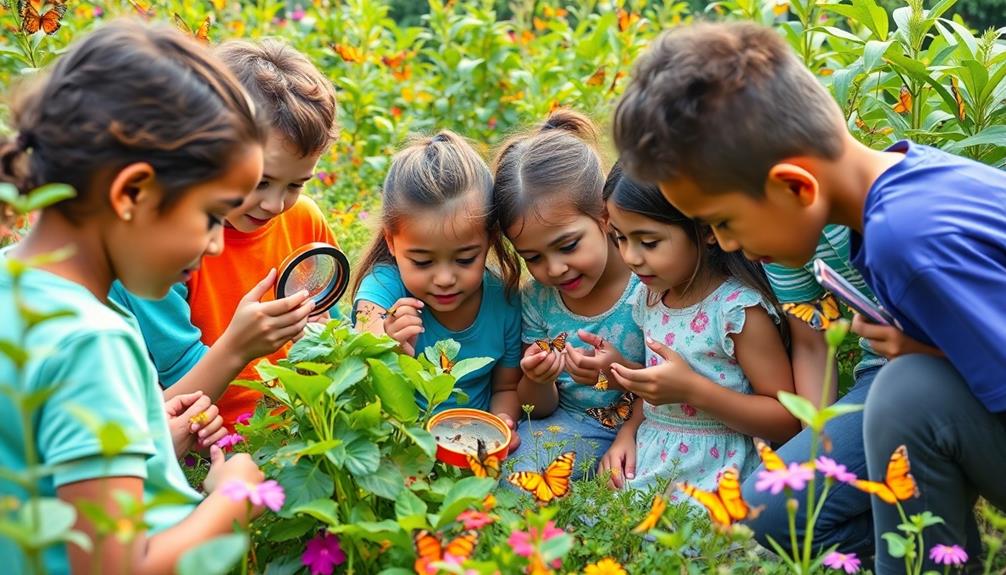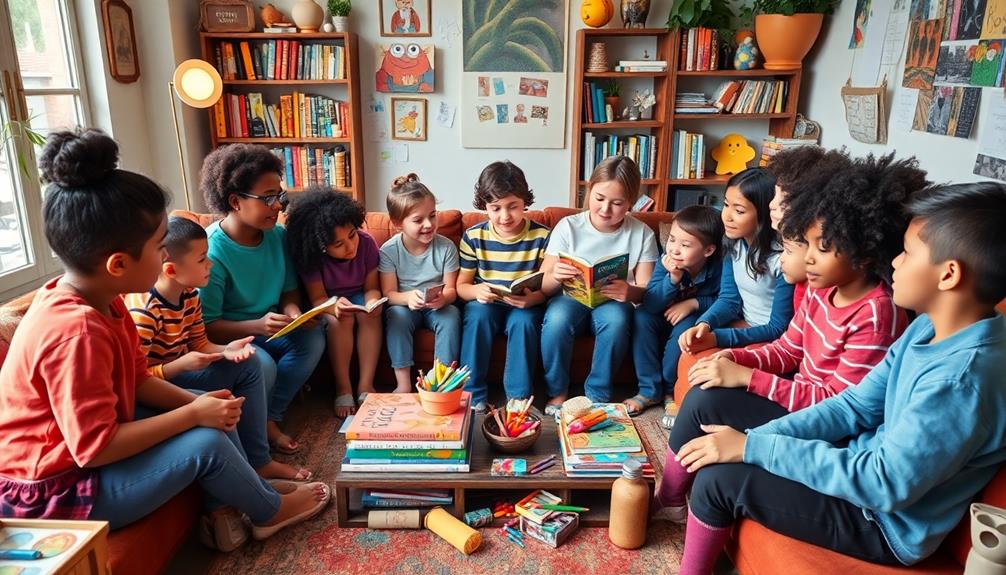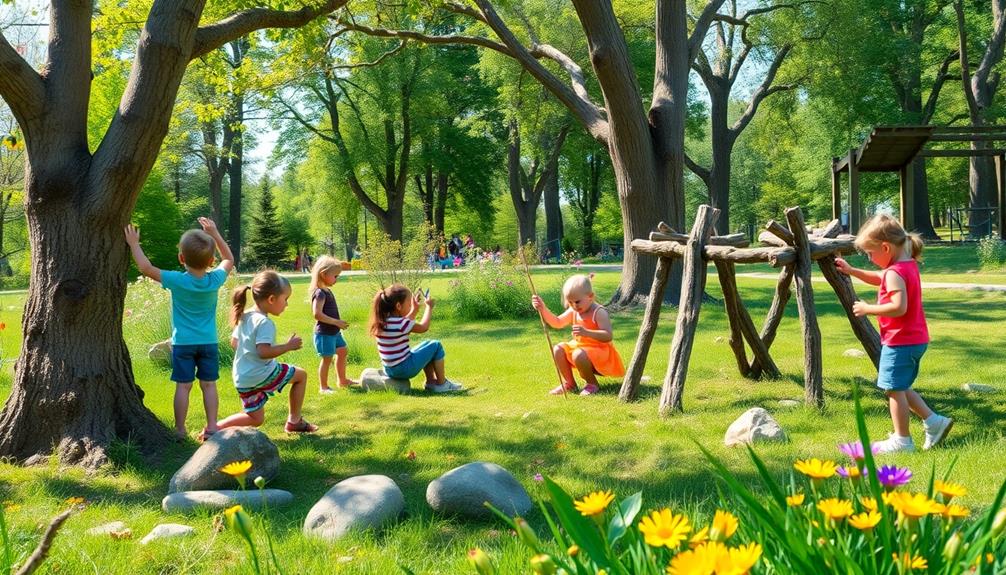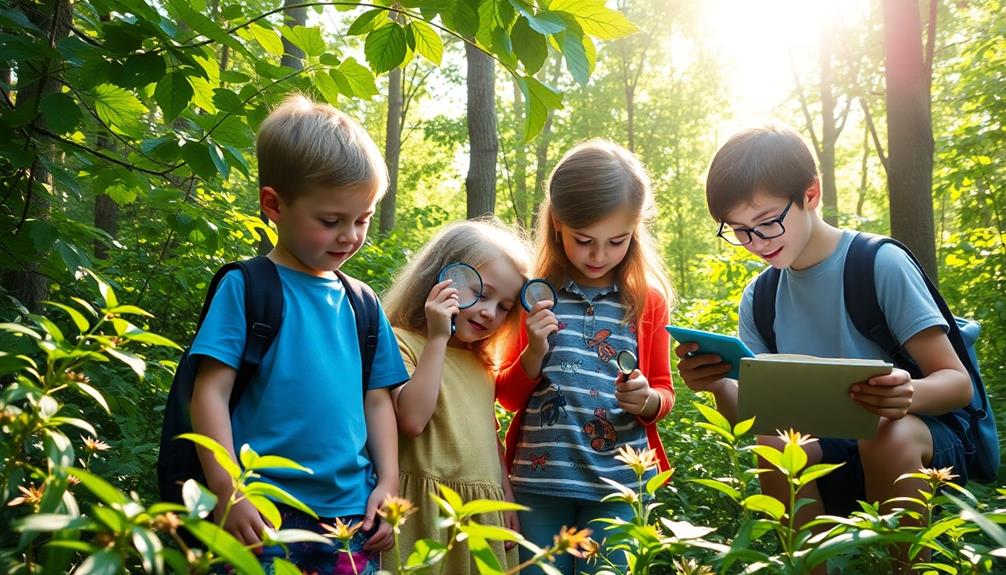Encouraging curiosity in children and teens is essential for their growth and development. Start by creating a supportive environment that sparks interest and exploration. Model curiosity yourself; express wonder about the world around you. Tailor activities to their interests, and ask open-ended questions that promote critical thinking. Incorporate diverse reading materials to broaden their horizons. Engage in cooperative family activities and excursions to spark new ideas. Allow for unstructured playtime to foster creativity and independence. By following these tips, you'll help cultivate a love for learning that lasts a lifetime, and there's so much more to explore.
Key Takeaways
- Create a supportive environment with stimulating visuals and materials to inspire exploration and discovery.
- Model curiosity by expressing wonder about the world, encouraging children to ask questions and explore.
- Encourage open-ended questions that promote critical thinking and allow children to express their reasoning.
- Provide diverse reading materials to introduce new ideas and perspectives, expanding children's knowledge and fueling curiosity.
- Allow unstructured playtime, fostering creativity, independent decision-making, and enhancing problem-solving skills through exploration.
Importance of Curiosity

Curiosity plays an essential role in your child's development, acting as a natural instinct that drives them to explore and learn about the world around them. When children are curious, they ask questions, seek answers, and engage in experiences that shape their understanding. This drive not only enhances their cognitive skills but also nurtures emotional growth, fostering empathy and open-mindedness as they learn to appreciate diverse perspectives.
Research shows that children who exhibit curiosity tend to perform better academically and develop superior problem-solving skills, regardless of their background. By encouraging your child to explore their interests, you're laying the groundwork for a lifelong love of learning. This love is significant in an ever-changing world, where adaptability is key.
Curiosity also strengthens memory and cognitive functions, helping children retain knowledge more effectively. When children actively engage with their environment, they become more invested in their education and personal development.
Tips for Nurturing Curiosity

Nurturing curiosity in children and teens involves creating an environment that supports exploration and discovery. Start by modeling curiosity yourself; when you express wonder about the world around you, your child is likely to emulate that behavior.
Tailor activities to align with your child's interests, as this can greatly enhance their motivation to explore. Encouraging open-ended play can also foster creativity and problem-solving skills, which are critical for cognitive development and emotional resilience play's role in development.
Encourage open-ended questions during conversations. By asking questions that can't be answered with a simple "yes" or "no," you stimulate their critical thinking and help them articulate their thoughts.
Additionally, provide access to diverse reading materials. Exposure to various genres and topics fosters imagination and expands your child's knowledge base, fueling their curiosity further.
Lastly, create a stimulating environment filled with intriguing visuals and safe exploration materials. This invites your child to engage in imaginative play and inquiry, allowing them to dive deeper into their interests.
Creating a Stimulating Environment

To spark curiosity, you need to create an environment filled with intriguing visuals and safe materials that invite exploration.
Incorporating tools that enhance digital creativity can also provide children with new avenues for inquiry and expression.
Regularly changing up toys and objects keeps things fresh, encouraging your child to engage and ask questions.
Don't forget to include unstructured playtime, where they can release their imagination and creativity without limits.
Intriguing Visuals and Materials
When designing a stimulating environment for children and teens, incorporating intriguing visuals and engaging materials plays an essential role in capturing their attention. You can use colorful artwork, interactive displays, and vibrant decorations to create a visually rich space that sparks curiosity.
Including natural elements like plants or nature-themed items fosters a connection to the outdoors and encourages questions about the world around them. Additionally, integrating STEM toys can enhance critical thinking and problem-solving skills, further igniting their interest in exploration.
To promote hands-on learning, provide exploration materials such as puzzles, building blocks, and sensory bins. These tools invite children to engage in unstructured play, allowing them to experiment freely and develop their creativity.
Regularly rotating toys and objects keeps the environment fresh, maintaining their interest and promoting ongoing curiosity.
Safe Exploration Opportunities
Creating safe exploration opportunities is essential for encouraging curiosity in children and teens. By designing spaces with intriguing visuals and safe materials, you can foster an environment where they feel comfortable to engage and discover new aspects of their world. Remember to rotate toys and objects regularly, keeping their interest piqued and motivating them to interact in different ways.
Here's how you can create a stimulating environment for your child:
| Strategy | Description |
|---|---|
| Use Safe Materials | Select age-appropriate, non-toxic items for play. |
| Rotate Toys | Keep playtime fresh by introducing new items often. |
| Encourage Experimentation | Allow your child to explore without fear of failure. |
| Provide Visual Stimulation | Decorate spaces with interesting colors and shapes. |
| Tailor Resources to Interests | Use materials that align with your child's natural interests. |
Unstructured Playtime Importance
Unstructured playtime is fundamental for children's development, offering a space where they can explore and create without limitations. During this time, kids can immerse themselves in their interests and release their creativity, which greatly boosts their curiosity in children.
Free play encourages them to face challenges head-on, fostering important problem-solving skills as they navigate situations without predefined rules.
Moreover, unstructured playtime plays a critical role in emotional growth. It allows children to express themselves freely and manage their feelings in a safe environment. When they engage in play, they learn to handle emotions like frustration and excitement, which contributes to their overall well-being.
Additionally, studies show that kids who regularly participate in unstructured play develop better social skills. They learn to collaborate, negotiate, and resolve conflicts with their peers, establishing strong interpersonal relationships.
This interactive environment nurtures their ability to communicate and work together, key skills for life.
The Role of Reading

Reading plays an essential role in nurturing curiosity among children and teens. By diving into various genres and reading books, you expose them to new ideas and perspectives that spark their interest. This exploration fuels their children's natural curiosity, allowing them to learn about the world in engaging ways. When kids find books that align with their interests, it fosters curiosity and encourages them to dig deeper into topics they love.
Establishing regular reading routines not only helps develop a lifelong love for literature but also expands their vocabulary and critical thinking skills, essential for academic success. Challenge your child with books above their current reading level; this pushes them to engage with complex topics and builds confidence.
Furthermore, storytelling and reading together create bonding opportunities that enhance shared learning experiences. These moments can ignite a child's passion for exploration and inquiry, encouraging them to ask questions and seek answers.
Encouraging Family Engagement

Family engagement can greatly enhance a child's curiosity and desire to learn. By participating in family activities like cooking or crafting, you promote cooperation and creativity, essential for nurturing their curiosity.
Planning excursions to museums or nature parks gives your child new experiences and opportunities to explore, fostering a love for learning.
Regular family discussions about daily experiences help children express their thoughts and ask questions. This dialogue enhances critical thinking skills and encourages them to engage in discussions about what they've seen or learned.
Additionally, participating in community events exposes your child to diverse cultures and perspectives, broadening their understanding of the world and igniting their curiosity.
Establishing a family reading routine where everyone shares what they're reading can also be valuable. It promotes a shared love for literature and encourages inquisitive dialogue.
When you create an environment filled with exploration and open communication, you not only nurture your child's curiosity but also instill a lifelong passion for learning.
Open-Ended Questions and Discussions

Asking open-ended questions sparks critical thinking and encourages kids to share their thoughts freely.
When you invite them into discussions, it helps them articulate their ideas and understand their own reasoning.
This open dialogue not only builds their confidence but also nurtures a genuine love for learning.
Stimulating Critical Thinking
Encouraging curiosity in children and teens often starts with open-ended questions that spark their imagination. By asking open-ended queries like, "What do you think would happen if…?" you invite them to explore possibilities, enhancing their critical thinking skills. This approach not only stimulates curiosity but also nurtures their drive to understand the world around them.
Reflect on these strategies to foster critical thinking:
- Encourage them to explain their reasoning when discussing their thoughts.
- Engage in conversations about real-world scenarios, allowing them to articulate their views.
- Challenge them with ethical dilemmas to contemplate multiple perspectives.
Research shows that children regularly asked open-ended questions demonstrate greater cognitive flexibility and creativity.
These discussions empower them to express their ideas freely, leading to deeper engagement with topics. As they navigate through various outcomes and perspectives, they develop stronger critical thinking skills, which are essential for their growth.
Encouraging Open Dialogue
To foster open dialogue with children and teens, it's crucial to create an environment where they feel comfortable sharing their thoughts. You can do this by using open-ended questions like, "What do you think would happen if…?" These questions encourage them to engage in deeper conversations, allowing them to explore their ideas and express their curiosity.
When you discuss hypothetical situations or feelings, you help cultivate their emotional intelligence. This practice enhances their ability to articulate thoughts and understand diverse perspectives. Research shows that asking open-ended questions not only promotes curiosity but also bolsters reasoning skills, leading to improved problem-solving abilities and better academic performance.
It's important to allow children to guide conversations based on their interests. This approach leads to more meaningful discussions, increasing their engagement and enthusiasm for learning.
Benefits of Unstructured Play

Unstructured play is an essential part of childhood development, offering numerous benefits that shape a child's growth. When kids engage in free play, they release their creativity and curiosity, enhancing cognitive development and problem-solving skills. This type of play isn't just about fun; it also promotes crucial social skills.
Children learn to negotiate, collaborate, and resolve conflicts with their peers, building relationships in the process.
Here are a few key benefits of unstructured play:
- It fosters independent decision-making, helping kids build confidence in their abilities.
- It supports emotional regulation, allowing children to express their feelings and manage stress in a safe environment.
- It encourages physical activity, combating sedentary habits and promoting overall health.
Frequently Asked Questions
How Do You Stimulate Curiosity in Children?
To stimulate curiosity in children, start by asking open-ended questions that spark their imagination. Show genuine wonder about the world around you, encouraging them to explore.
Create a stimulating environment filled with interesting visuals and safe materials for exploration. Allow unstructured playtime for them to make decisions and think creatively.
Follow their interests and provide resources that align with their passions, and introduce diverse experiences to broaden their understanding of different concepts.
How Do You Encourage Students Curiosity?
When it comes to encouraging students' curiosity, you've got to strike while the iron's hot.
Start by creating a classroom atmosphere where questioning is welcomed, and celebrate those "aha" moments. Incorporate hands-on activities that connect lessons to real-life experiences.
Offer diverse reading materials that pique their interests, and model your own curiosity during discussions.
How Do You Stimulate Curiosity?
To stimulate curiosity, start by asking open-ended questions that spark discussion.
Create an environment filled with diverse materials that invite exploration.
Show your own curiosity by expressing wonder about everyday things.
Allow for unstructured play, giving room for discovery and problem-solving.
Utilize local libraries and community resources to introduce new topics and experiences.
What Activity Encourages Curiosity?
When you think outside the box, activities like hands-on science experiments can really spark curiosity.
You'll find that baking together also engages your senses and teaches cause and effect.
Exploring nature, whether it's a park or a simple backyard, allows for unstructured play, where discoveries happen naturally.
Plus, reading diverse books can lead to fascinating discussions.
Don't forget to ask open-ended questions—these prompt deeper thinking and exploration of interests.
Conclusion
So, if you want to stifle your child's curiosity, just stick to a strict routine and avoid any questions that might spark their imagination. But if you're actually interested in fostering a sense of wonder, embrace the chaos of open-ended conversations and unstructured play. After all, who needs a curious mind when you can have a perfectly predictable life? Remember, curiosity might just lead to amazing discoveries, but hey, that's a risk some parents aren't willing to take!









